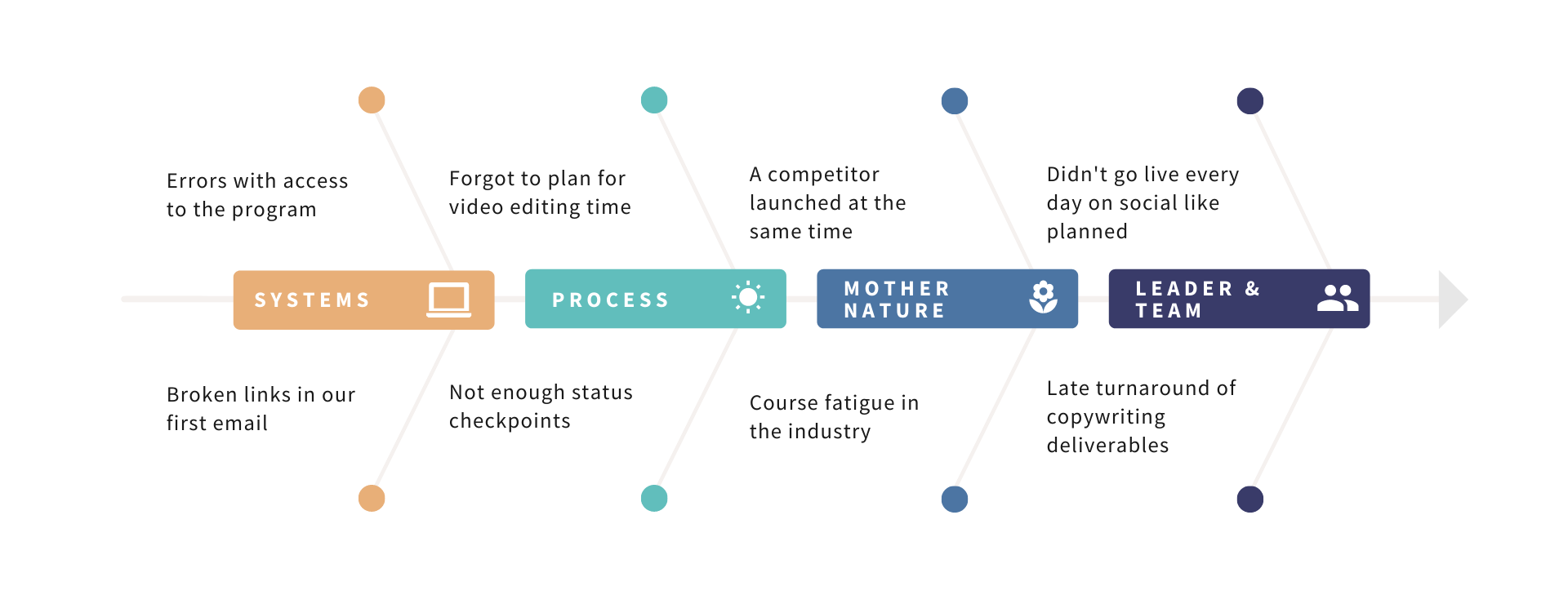Rarely do things ever go according to plan in life, business included. You know this because you’ve experienced it plenty of times. Tech failures on launch day. Misprints from the printer on a large order. Emails getting sent to the wrong segment of subscribers.
If you haven’t had a facepalm moment yet in your business, I hope the streak continues. (But keep reading because when that facepalm comes, you’ll be much more prepared if you know how to get to the bottom of what’s happening.)
What is Root Cause Analysis?
Sometimes your projects don’t work out, and that’s okay. It’s part of business and it happens to everyone. That doesn’t mean you should breeze past what happened either. Mistakes and missteps are an opportunity to learn something new and be better equipped the next time you face a situation.
In business, you want to stop problems from happening repeatedly. Maybe it was a membership launch that cost you more money to create than what you bought it. Maybe it was a month of strikingly low sales.
A Root Cause Analysis allows you to get to the bottom of what’s happening and identify the true cause of a problem. Understanding what caused the issue can mitigate problems as they arise — and maybe even prevent them from happening in the future.
It can also help you take the emotion out of the process. As an entrepreneur, your business successes (and fallbacks) can often become entwined with your perception of yourself. These tools can help you objectively pinpoint areas with specific and actionable steps for improvement.
When to use a Root Cause Analysis in your business
Mishaps don’t always happen slowly. There will be times when you have to respond immediately to troubleshoot a problem. Once the situation is under control, though, it’s time to examine what happened and document it.
The first step is to identify the problem you want to solve. A few examples could be:
- “Why weren’t there any sales for that brand-new product I created?”
- “Why have our members been leaving the program after 2 months?”
- “Why aren’t my holiday products selling?”
- “Why are we getting so many complaints about the packaging?”
Then, you need to ask questions that can break down the events leading up to the issue. The main thing with this exercise is to do what you can to figure out cause and effect. Solutions will come from your findings.
Practical ways to implement a Root Cause Analysis
Sometimes the answer will be obvious. You’ll quickly realize that a step was missed somewhere in the workflow by either you or a member of your team. That’s okay — we’re all human and are prone to making mistakes every once in a while.
If you already know the immediate solution, a Root Cause Analysis may not be the next right step for you. You can simply implement the improvement (in this case, a checklist to double-check before moving on could prevent a similar failure in the future). A word of warning, however, because it’s easy to put superficial solutions in place that won’t address the real issues.
But for those times when you’re unsure what’s going on, there are large-scale issues, or frequent, smaller mistakes keep occurring — a Root Cause Analysis can be especially useful to uncovering and addressing deficiencies that are taking a toll on your business.
The 5 Whys
This exercise is simple — just ask yourself “why” five times to help identify what’s really going on.
- Problem: Why didn’t we make any sales?
- Why: Because nobody knew about it!
- Why: There weren’t any ads for the new product.
- Why: The marketing team didn’t have details on the launch until 5 days before it started.
The one downside to this approach is that it can promote singular thinking, especially if you’re doing this activity solo. There isn’t only one path to the bottom, but as long as you’re aware that there could be more than one potential root cause, this exercise is a simple way to work things out.
Also, there’s nothing magical about the number five. If you hit a root cause after two Why’s, that’s fine!
The Fishbone Diagram
Where the 5 Whys exercise often falls short, the cause-and-effect diagram (also called the fishbone diagram) can pick up the slack. It can help you visually organize focus areas that may be causing the problem and guide the discussion toward evaluating categories you may not have considered while answering your “whys.”

The 6 Ms:
- Man (workers, leadership, management)
- Machine (systems, software, and equipment)
- Material (the materials used to create the item, including informational/thought-based inputs)
- Method (process)
- Measurement (ex. different systems measure different metrics making it hard to compare)
- Mother Nature (environmental issues, could be physical or industry-based)
Or the 4 Ps:
- Product (Is this the right product for my customers? Is it different enough from what’s out there?)
- Price (Are customers getting a good value? Are we over/underpriced?)
- Promotion (Are we marketing it well? Are our customers on the channel we’re marketing to?)
- Place (Are we ranking on Google? Does our Instagram lead to our product page? How accessible is it to find and buy our product?)
After you complete your Fishbone Diagram, take a moment to circle the areas you want to further investigate. Remember, this tool is a brainstorming tool—you still need data to back up the claim that it is actually a cause of the problem.
The Flowchart
A flowchart diagram represents the steps in a process or procedure and then visually maps out how the process flows. You can put it together with sticky notes on your wall, write it down on paper, or through digital software with draw.io or LucidChart.

The key shapes you will utilize are:
- Ovals: mark the start and end of a process
- Arrows: connect steps together
- Rectangles: indicate a step in the process
- Diamonds: indicate a decision point in the process
Flowcharts are great for catching bottlenecks and points of confusion as you work your way through the flow. If you want to get really tactical, you can start overlaying metrics at key points.
How many people are landing on the Landing page and making it onto the Thank You page? Plot that on the arrow between the two. How many “Yes” and “No” paths are taken when it comes to the Purchase diamond?
Keep the momentum going
Routinely conducting Root Cause Analysis in your business is a great way to ensure you always have a solid strategy and working procedure. You’ll be able to continuously improve your products and services while providing the best experience possible for your clients and customers.
But sometimes the issue lies in poor planning — onboarding new team members with not a lot of information, starting from scratch with every project because nothing is written down — the list goes on.
If you want to help avoid the problems before they even start, getting your standard operating procedures (SOPs) structured from the go can help you do that.
Creating SOPs for your business can streamline your workflow, help answer questions, and back everything you’re doing with a quality assurance check.
If you have a team now or ever want one in the future, even if it’s just hiring a contractor for a few hours a week, you need to get your SOPs sorted out.
In my online shop, you can purchase an SOP template that includes everything you need to get this done the right way, including a procedure documentation example and various file types!

Be the first to comment